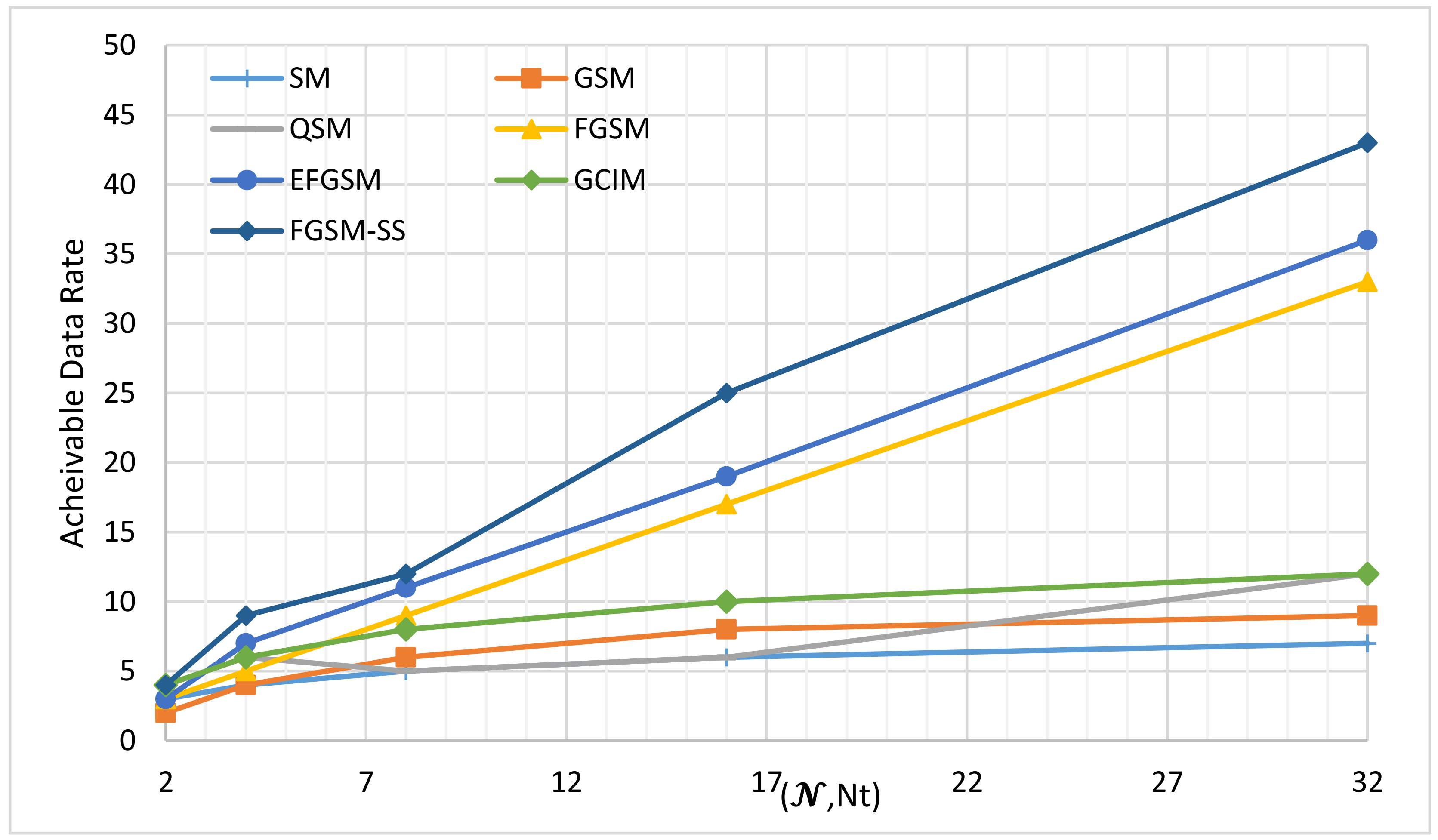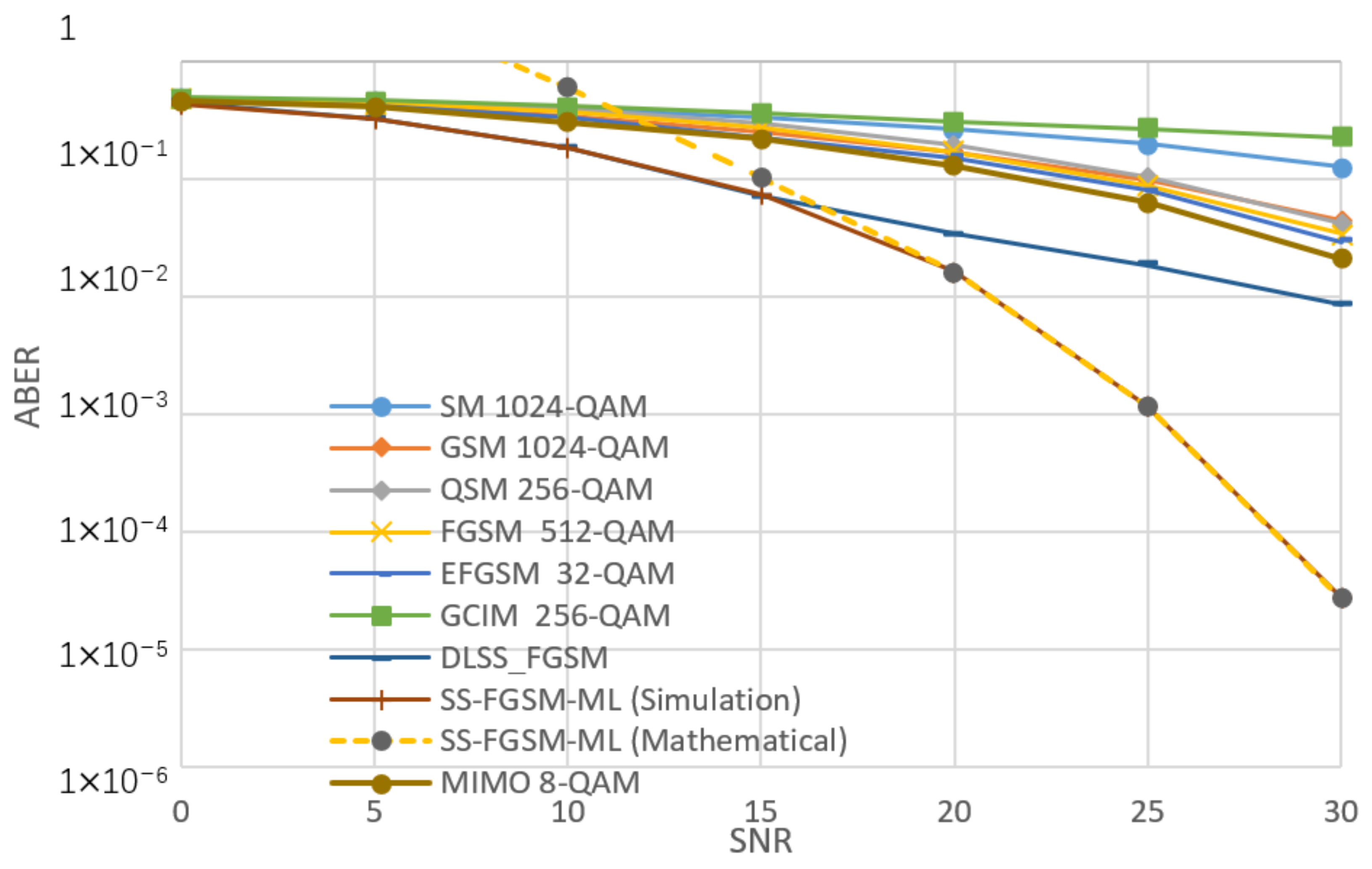Deep Learning-Based Spread-Spectrum FGSM for Underwater Communication
Abstract
1. Introduction
- The SS-FGSM scheme is proposed, which employs additional index representation by using spreading code to transmit more information data bits. The Walsh code is considered as a spreading code in this paper due to its perfect orthogonality. Thus, SS-FGSM can carry additional bits by index leading to improve both the data rate and the energy efficiency.
- A new detector with low computation complexity is proposed to relax the receiver-ML based detector computation complexity and save the system consumed power. A deep learning-based detector is proposed to be used in the proposed SS-FGSM underwater communication scheme. In order to adapt the deep learning-based detector for the UWA channel, which is considered to be time-varied, data are first preprocessed to recover the UWA channel effects, and then the deep learning is employed for detecting the index of active antennas, spreading codes, and physical transmitted bits jointly.
- The general mathematical framework for the proposed SS-FGSM performances is laid out thoroughly and an extensive simulation is provided to demonstrate the superiority of the proposed scheme over its benchmarks. It is shown that despite the low-complex detector, the proposed scheme is still outperforming the benchmark with the ML.
2. Related Work
3. Proposed SS-FGSM Scheme
3.1. Underwater Acoustic Channel
3.2. Conventional FGSM Scheme
3.3. SS-FGSM Scheme
3.4. Deep Learning-Based Detector
3.5. Structure of DL-Based Detector
3.6. Training Procedure
3.7. Online Deployment
4. SS-FGSM Performance Analysis
4.1. ABER Performance Analysis
4.2. Energy Efficiency
4.3. Receiver Complexity
5. Simulation Results
5.1. Achievable Data Rate
5.2. ABER Performance Analysis
5.3. Energy Efficiency Analysis
5.4. Receiver’s Complexity
6. Conclusions
Author Contributions
Funding
Conflicts of Interest
References
- Singer, A.C.; Nelson, J.K.; Kozat, S.S. Signal Processing for Underwater Acoustic Communications. IEEE Commun. Mag. 2009, 47, 90–96. [Google Scholar] [CrossRef]
- Xerri, B.; Cavassilas, J.-f.; Borloz, B. Passive tracking in underwater acoustic. Signal Process. 2002, 82, 1067–1085. [Google Scholar] [CrossRef]
- Qasem, Z.A.; Esmaiel, H.; Sun, H.; Wang, J.; Miao, Y.; Anwar, S. Enhanced Fully Generalized Spatial Modulation for the Internet of Underwater Things. Sensors 2019, 19, 1519. [Google Scholar] [CrossRef] [PubMed]
- Esmaiel, H.; Qasem, Z.A.H.; Sun, H.; Wang, J.; Rehman Junejo, N.U. Underwater Image Transmission Using Spatial Modulation Unequal Error Protection for Internet of Underwater Things. Sensors 2019, 19, 5271. [Google Scholar] [CrossRef] [PubMed]
- Junejo, N.U.R.; Esmaiel, H.; Zhou, M.; Sun, H.; Qi, J.; Wang, J. Sparse Channel Estimation of Underwater TDS-OFDM System using Look-ahead Backtracking Orthogonal Matching Pursuit. IEEE Access 2018, 6, 74389–74399. [Google Scholar] [CrossRef]
- Sendra, S.; Lloret, J.; Rodrigues, J.J.; Aguiar, J.M. Underwater wireless communications in freshwater at 2.4 GHz. IEEE Commun. Lett. 2013, 17, 1794–1797. [Google Scholar] [CrossRef]
- Lloret, J.; Sendra, S.; Ardid, M.; Rodrigues, J.J. Underwater wireless sensor communications in the 2.4 GHz ISM frequency band. Sensors 2012, 12, 4237–4264. [Google Scholar] [CrossRef] [PubMed]
- Li, B.; Member, S.; Huang, J.; Zhou, S.; Ball, K.; Stojanovic, M.; Member, S.; Freitag, L.; Willett, P. MIMO-OFDM for High-Rate Underwater Acoustic Communications. IEEE J. Ocean. Eng. 2009, 34, 634–644. [Google Scholar]
- Goldsmith, A. Wireless Communications; Cambridge University Press: Cambridge, UK, 2005. [Google Scholar]
- Tse, D.; Viswanath, P. Fundamentals of Wireless Communications; Cambridge University Press: Cambridge, UK, 2005. [Google Scholar]
- Yang, T.C. Spatially Multiplexed CDMA Multiuser UnderwaterAcoustic Communications. IEEE J. Ocean. Eng. 2016, 41, 217–231. [Google Scholar] [CrossRef]
- Cheng, C.C.; Sari, H.; Sezginer, S.; Su, Y.T. New Signal Designs for Enhanced Spatial Modulation. IEEE Trans. Wirel. Commun. 2016, 15, 7766–7777. [Google Scholar] [CrossRef]
- Mesleh, R.Y.; Haas, H.; Sinanovi, S. Spatial Modulation. IEEE Trans. Veh. Technol. 2008, 57, 2228–2241. [Google Scholar] [CrossRef]
- Di Renzo, M.; Haas, H.; Grant, P.M. Spatial modulation for multiple-antenna wireless systems: A survey. IEEE Commun. Mag. 2011, 49, 182–191. [Google Scholar] [CrossRef]
- Younis, A.; Serafimovski, N.; Mesleh, R.; Haas, H. Generalised spatial modulation. In Proceedings of the 2010 Conference Record of the Forty Fourth Asilomar Conference on Signals, Systems and Computers, Pacific Grove, CA, USA, 7–10 November 2010; pp. 1498–1502. [Google Scholar]
- Narasimhan, T.L.; Raviteja, P.; Chockalingam, A. Generalized Spatial Modulation in Large-Scale Multiuser MIMO Systems. IEEE Trans. Wirel. Commun. 2015, 14, 3764–3779. [Google Scholar] [CrossRef]
- Hussein, H.S.; Esmaiel, H.; Jiang, D. Fully generalised spatial modulation technique for underwater communication. Electron. Lett. 2018, 54, 12–13. [Google Scholar] [CrossRef]
- Mesleh, R.; Member, S.; Ikki, S.S.; Aggoune, H.M. Quadrature Spatial Modulation. IEEE Trans. Veh. Technol. 2014, 9545, 1–5. [Google Scholar] [CrossRef]
- Mesleh, R.; Althunibat, S.; Younis, A. Differential Quadrature Spatial Modulation. IEEE Trans. Commun. 2017, 65, 3810–3817. [Google Scholar] [CrossRef]
- Hussein, H.S.; Elsayed, M.; Mohamed, U.S.; Esmaiel, H.; Mohamed, E.M. Spectral Efficient Spatial Modulation Techniques. IEEE Access 2019, 7, 1454–1469. [Google Scholar] [CrossRef]
- Cheng, C.C.; Sari, H.; Sezginer, S.; Su, Y.T. Enhanced Spatial Modulation with Multiple Signal Constellations. IEEE Trans. Commun. 2015, 63, 2237–2248. [Google Scholar] [CrossRef]
- Zhao, T.Z.Z.Y.Y. Partial-code-aided scheme for narrowband interference suppression in direct-sequence spread spectrum systems. IET Commun. 2010, 4, 2240–2251. [Google Scholar] [CrossRef]
- Wu, X.; Yang, Z.; Yan, J.; Cui, J. Low-rate turbo-Hadamard coding approach for narrow-band interference suppression. In Proceedings of the 2014 IEEE International Conference on Communications (ICC), Sydney, Australia, 10–14 June 2014; pp. 2130–2134. [Google Scholar]
- Kaddoum, G.; Ahmed, M.F.A.; Nijsure, Y. Code index modulation: A high data rate and energy efficient communication system. IEEE Commun. Lett. 2015, 19, 175–178. [Google Scholar] [CrossRef]
- Kaddoum, G.; Nijsure, Y.; Tran, H. Generalized code index modulation technique for high-data-rate communication systems. IEEE Trans. Veh. Technol. 2016, 65, 7000–7009. [Google Scholar] [CrossRef]
- Jeganathan, J.; Ghrayeb, A.; Szczecinski, L.; Ceron, A. Space shift keying modulation for MIMO channels. IEEE Trans. Wirel. Commun. 2009, 8, 3692–3703. [Google Scholar] [CrossRef]
- Di Renzo, M.; Haas, H. Space shift keying (SSK) modulation with partial channel state information: Optimal detector and performance analysis over fading channels. IEEE Trans. Commun. 2010, 58, 3196–3210. [Google Scholar] [CrossRef]
- Renzo, M.D.; Haas, H. Space Shift Keying (SSK—) MIMO over Correlated Rician Fading Channels: Performance Analysis and a New Method for Transmit-Diversity. IEEE Trans. Commun. 2011, 59, 116–129. [Google Scholar] [CrossRef]
- Jeganathan, J.; Ghrayeb, A.; Szczecinski, L. Generalized Space Shift Keying Modulation for MIMO Channels. In Proceedings of the 2008 IEEE 19th International Symposium on Personal, Indoor and Mobile Radio Communications, Cannes, France, 15–18 September 2008. [Google Scholar]
- Ntontin, K.; Renzo, M.D.; Perez-neira, A.; Verikoukis, C. Adaptive generalized space shift keying. J. Wirel. Commun. Netw. 2013, 2013, 43. [Google Scholar] [CrossRef]
- Li, J.; Wen, M.; Cheng, X.; Member, S.; Yan, Y.; Song, S.; Lee, M.H.; Member, L.S. Generalised Pre-coding Aided Quadrature Spatial Modulation. IEEE Trans. Veh. Technol. 2016, 9545, 1–5. [Google Scholar]
- Alwakeel, M.M. Quadrature Spatial Modulation Performance Analysis over Rician Fading Channels. J. Commun. 2016, 11, 249–254. [Google Scholar] [CrossRef]
- Mesleh, R.; Ikki, S.S. On the impact of imperfect channel knowledge on the performance of quadrature spatial modulation. In Proceedings of the 2015 IEEE Wireless Communications and Networking Conference (WCNC), New Orleans, LA, USA, 9–12 March 2015; pp. 534–538. [Google Scholar]
- Cogen, F.; Aydin, E.; Kabaoglu, N.; Basar, E.; Ilhan, H. Code Index Modulation and Spatial Modulation: A New High Rate and Energy Efficient Scheme for MIMO Systems. In Proceedings of the 2018 41st International Conference on Telecommunications and Signal Processing (TSP), Athens, Greece, 4–6 July 2018; pp. 1–4. [Google Scholar]
- Jeyadeepan, J.; Ghrayeb, A.; Szczecinski, L. Spatial modulation: Optimal detection and performance analysis. IEEE Commun. Lett. 2015, 12, 545–547. [Google Scholar]
- Xu, H.J.; Al-Mumit Quazi, T.; Naidoo, N.R. Spatial modulation: Optimal detector asymptotic performance and multiple-stage detection. IET Commun. 2011, 5, 1368–1376. [Google Scholar]
- Liu, Z.; Yang, T. On overhead reduction in time-reversed OFDM underwater acoustic communications. IEEE J. Ocean. Eng. 2013, 39, 788–800. [Google Scholar] [CrossRef]
- Esmaiel, H.; Jiang, D. Spectrum and Energy Efficient OFDM Multicarrier Modulation for an Underwater Acoustic Channel. Wirel. Pers. Commun. 2017, 96, 1577–1593. [Google Scholar] [CrossRef]
- Li, B.; Zhou, S.; Stojanovic, M. Multicarrier Communication over Underwater Acoustic Channels with Nonuniform Doppler Shifts. IEEE J. Ocean. Eng. 2008, 33, 198–209. [Google Scholar]
- D’Amours, C.; Dahmane, A.O. Spreading code assignment strategies for MIMO-CDMA systems operating in frequency-selective channels. EURASIP J. Wirel. Commun. Netw. 2009, 2009, 53. [Google Scholar] [CrossRef]
- Schmidhuber, J. Deep learning in neural networks: An overview. Neural Netw. 2015, 61, 85–117. [Google Scholar] [CrossRef]
- Zhang, Y.; Li, J.; Zakharov, Y.; Li, X.; Li, J. Deep learning based underwater acoustic OFDM communications. Appl. Acoust. 2019, 154, 53–58. [Google Scholar] [CrossRef]
- Qarabaqi, P.; Stojanovic, M. Statistical characterization and computationally efficient modeling of a class of underwater acoustic communication channels. IEEE J. Ocean. Eng. 2013, 38, 701–717. [Google Scholar] [CrossRef]









| Description | Notation | Description | Notation | Description | Notation | Description | Notation |
|---|---|---|---|---|---|---|---|
| Number of transmit antennas | Walsh codes | Number of available spreading code | Imaginary part of the block of bits | ||||
| Number of receive antennas | Number of code chips | Energy required for transmitted bit | Weights of layers | ||||
| The achieved data rate | Chip period | Doppler scaling factor | The transmitted signal | ||||
| Modulation order | Pulse shaping filter | Channel delays | Block of bits | ||||
| Number of multipath | Carrier frequency | Modulated symbol | Learning rate | ||||
| Number of active antennas | Biases of the layers | Additive white Gaussian noise | Real part of the block of bits | ||||
| Index of the active antenna | Probability associated with erroneous spreading code | Channel time-varying path amplitudes | Probability associated with the modulated bits | ||||
| Real part of modulated symbol | Length of the first hidden later |
| Transmitted Bits | Antenna Combination | ||
|---|---|---|---|
| Data Bits | Codes Bits | Antennas Bits | |
| 000 | |||
| 001 | |||
| 010 | |||
| 011 | |||
| 100 | |||
| 101 | |||
| 110 | |||
| 111 | |||
| SM | 32,768 |
| GSM | 65,536 |
| QSM | 32,768 |
| FGSM | 65,536 |
| EFGSM | 1280 |
| GCIM | 352 |
| MLSS-FGSM | 262,144 |
| DLSS-FGSM | 5376 |
Publisher’s Note: MDPI stays neutral with regard to jurisdictional claims in published maps and institutional affiliations. |
© 2020 by the authors. Licensee MDPI, Basel, Switzerland. This article is an open access article distributed under the terms and conditions of the Creative Commons Attribution (CC BY) license (http://creativecommons.org/licenses/by/4.0/).
Share and Cite
Qasem, Z.A.H.; Esmaiel, H.; Sun, H.; Qi, J.; Wang, J. Deep Learning-Based Spread-Spectrum FGSM for Underwater Communication. Sensors 2020, 20, 6134. https://doi.org/10.3390/s20216134
Qasem ZAH, Esmaiel H, Sun H, Qi J, Wang J. Deep Learning-Based Spread-Spectrum FGSM for Underwater Communication. Sensors. 2020; 20(21):6134. https://doi.org/10.3390/s20216134
Chicago/Turabian StyleQasem, Zeyad A. H., Hamada Esmaiel, Haixin Sun, Jie Qi, and Junfeng Wang. 2020. "Deep Learning-Based Spread-Spectrum FGSM for Underwater Communication" Sensors 20, no. 21: 6134. https://doi.org/10.3390/s20216134
APA StyleQasem, Z. A. H., Esmaiel, H., Sun, H., Qi, J., & Wang, J. (2020). Deep Learning-Based Spread-Spectrum FGSM for Underwater Communication. Sensors, 20(21), 6134. https://doi.org/10.3390/s20216134







